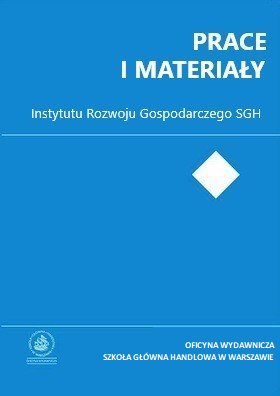The Viterbi path of hidden Markov models in an analysis of business tendency surveys
Main Article Content
Abstract
summ.AbstraktThe aim of the paper is to show that turning points detection can be treated as a problem of pattern recognition. In the paper there are presented the results of applying normal hidden Markov models to a number of survey balances. Beyond a classical two-scale assessment of business activity a slightly more fuzzy classification of states is considered. To determine periods of unclear or difficult to evaluate situation unobservable Markov chains with three and four states are introduced. The outputs of the Viterbi algorithm, i.e. the most likely paths of unobservable states of Markov chains, are a basis of the proposed classification. The comparison of these paths with the business cycle turning points dated by OECD is described. The results obtained for three- and four-state Markov chains are close to those established in the references time series and seem to improve the speed with which, especially downshifts, are signaled. Furthermore, these results are more favorable than outcomes provided by conventional two-state models. The method proposed in this paper seems to be a very effective tool to analyze results of business tendency surveys, in particular, when multistate Markov chains are considered. Moreover, proposed decompositions allow an easy comparison of two time series as far as turning point are concerned. In the paper survey balances are compared with 'hard' economic data such as sold manufacturing production. The results confirm the accuracy of assessment provided by survey respondents.(original abstract)
Article Details
References
Abberger, K., Nierhaus, W. (2010). Markov-switching and the Ifo business climate: the Ifo business cycle traffic lights, Journal of Business Cycle Measurement and Analysis, 2, 1-13.
Addo, P. M., Billio, M., Guegan, D. (2012). Alternative methodology for turning point detection in business cycle: A wavelet approach, Documents de travail du Centre d’Economie de la Sorbonne, 23.
Artis, M. J., Krolzig, H-M., Taro, J. (1998). The European business cycle, CEPR Discussion Paper No. 2242.
Baum, L. E., Petrie, T., Soules, G., Weiss, N. (1970). A maximization technique occurring in the statistical analysis of probabilistic functions of Markov chains, The Annals of Mathematical Statistics, 41 (1), 164-171.
Bell, W. (1984). Signal extraction for nonstationary time series, Annals of Statistics, 12 (2), 646-664.
Bernardelli, M. (2013). Non-classical Markov models in the analysis of business cycles in Poland, Roczniki Kolegium Analiz Ekonomicznych SGH, 30, 59-74.
Bernardelli, M., Dędys, M. (2012). Hidden Markov models in analysis of results of business tendency surveys, Prace i Materiały Instytutu Rozwoju Gospodarczego SGH, 90, 159-181.
Birchenhal, C. R., Jessen, H., Osborn, D. R., Simpson, P. (1999). Predicting US business-cycle regimes, Journal of Business and Economic Statistics, 17 (3), 313-323.
Boldin, M. (1994). Dating turning points in the business cycle, Journal of Business, 67 (1), 97-131.
Çakmaklı, C., Paap, R., van Dijk, D. (2013). Measuring and predicting heterogeneous recessions, Journal of Economic Dynamics & Control, 37 (11), 2195-2216
Cappé, O, Moulines, E., Rydén, T. (2005). Inference in hidden Markov models, New York: Springer.
Chin, D., Geweke, J., Miller, P. (2000). Predicting turning points, Technical Report 267, Reserve Bank of Minneapolis.
Christiano, L. J., Fitzgerald, T. J. (2003). The band pass filter, International Economic Review, 44 (2), 435-465.
Cleveland, W. S. (1972). Analysis and forecasting of seasonal time series, PhD thesis, University of Wisconsin-Madison.
Drozdowicz-Bieć, M. (2008), Od recesji do boomu. Wahania cykliczne polskiej 1990-2007, Prace i Materiały Instytutu Rozwoju Gospodarczego SGH, 80, 25-40.
Hamilton, J. D. (1994). Time series analysis, Princeton.
Hodrick, R. J., Prescott, E. C. (1997), Postwar US business cycles: An empirical investigation, Journal of Money Credit and Banking, 29 (1), 1-16.
Koskinen, L., Oeller, L. E. (2004). A classifying procedure for signaling turning points, Journal of Forecasting, 23 (3), 197-214.
Lamy, R. (1997). Forecasting US recessions: Some further results from probit models, Technical report, Finance Canada.
Mitra, S., Date, P. (2010). Regime switching volatility calibration by the Baum-Welch method, Journal of Computational and Applied Mathematics, 234, 3243-3260.
Sensier, M., Artis, M., Osborn, D. R., Birchenhall, C. R. (2004). Domestic and international influences on business cycle regimes in Europe, International Journal of Forecasting, 20 (2), 343-357.
Wildi, M., Schips, B. (2005). Signal extraction: How (in)efficient are model-based approaches? An empirical study based on TRAMO-SEATS and Census X12-ARIMA, Technical Report 96, Zurich: KOF Swiss Economic Institute.
